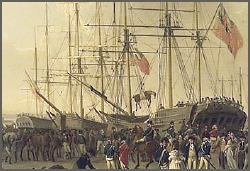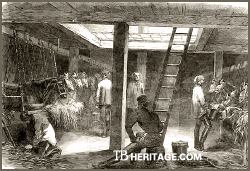|
|
The Voyage of the Flora: The Horses
 |
|
|
|
|  Follow the Route of the Flora Follow the Route of the Flora | |
|
By David Wilkinson for Thoroughbred Heritage. ©David Wilkinson, 2009. David Wilkinson is author of Early Horse Racing in Yorkshire and the Origins of the Thoroughbred (Old Bald Peg Publications, Old Byland, York; 2003) and a contributor to Thoroughbred Heritage.
| |
|
|
Transporting the Horses
From the Flora log account it appears that the horses were transported in a permanent standing position supported by slings between the decks. There was no provision for them to lie down, and they were clearly packed very close to each other. They may have been shackled.
As early as September 28th in a gale, there is a reference to Ruswarp dropping his hind legs and being supported entirely by the sling, while the others were "hard matchd to keep upon their legs." However, on November 2nd Manson records, "A Great sea from the West. Ship Labours very hard yet the Horses able Stand fast in ye hold but they Tumbled down several times upon ye deck."
On November 6th "Danby kicked Lofthouse very hard on his left hind Leg which is very much swollen to which we applyd a medicine for it." A few days later they blooded Lofthouse and applied a poultice to the swollen limb. Blooding seems to have been a routine to maintain health; "it being very Requisite against the Change of the Climate. They are in better order now than when they came on board the ship." A passing physician blooded Manson himself, for a non-specified illness. Blood letting of horses was frequently carried out by farriers with a fleam knife or specialised bleeding tubes. (1)
Clearly, they rubbed against the sides of their "stalls" and lost hair from their coats. Manson records for November 28th: "A Great Deal of Hair has pilled of Sulphur's Legs but he has Entirely Clear of Grease & all of them in Good Health." The reference to "grease" indicates a specific condition espressed by swelling of the heels or forefeet, and is a result of poor stable management.(2) However, Manson and his crew appear to have taken good care of their cargo, given their lack of professional horsemanship, and landed them in reasonable condition without loss, despite the long voyage and adverse weather. Of course, they had a financial interest in the cargo, but there is a hint of affection for the animals.
|
 | |  | |
| | Left: 1793 cavalry embarkation, probably to Ostend, with horses waiting to be loaded on ship via a canvas sling, a common method used through the 19th century. Image courtesy National Maritime Museum, London. Right: 1854 Royal Artillery Horses. Typical English military transport mid-19th century--horses were dropped by sling directly into the hold, "a strong padded stanchion placed between each horse; a canvas sling is also passed under his body, and fastened overhead, which prevents his lying down during the voyage, but acts as a great support to him when weary. On ... arriving, if the coast admits of it, the horses are dropped overboard, and allowed to find the best of their way to the shore." |
Almost one hundred years later, a similar method of horse transportation was used by the British Army to move large numbers of horses to the Crimean War, resulting in high mortality. The Earl of Albemarle raised the matter in an impassioned speech to the House of Lords on March 16th, 1855, on grounds of cruelty and expense:
"First of all a platform must be provided for the horses to stand upon, besides a number of pillars and posts and rails, as each horse was wedged in between four pillars that he was hardly able to move. In order to prevent the effects of great friction which must take place, Government went to a great expense in sheepskins, and each horse was provided with a set of slings to keep him upon his legs in bad weather ... what was likely to be the states of its sinews and tendons, when placed in a constrained position for so long a period?"
Albermarle wanted the cavalry to adopt the method long used by Thomas Kirby, a horse agent and shipper, living in York. Kirby shipped large numbers of valuable thoroughbred horses from the seaport of Hull, on the River Humber, from Yorkshire to Russia on behalf of the Tsar and his court. Kirby valued his Russian exports at £33,000. He described this "Hull" method:
"In sailing ships the horses are stowed in the hold...they stand without slinging on each side of the ship in separate stalls, as in a stable, leaving a passage in the centre for the grooms. My horses have always had sufficient room to lie down when disposed and have never suffered any injury...The size of the stalls in sailing vessels is eight feet in length by four in width. No upright stalling is required."
His Lordship received little satisfaction in the debate, though Lord Lucan (of Charge of the Light Brigade fame), not noted for his humanity, did offer some support.
Manson appears to have been lucking with his horses, given the length of the voyage and the inclement weather the Flora encountered crossing the Atlantic.
The Horses in Charleston
On landing at Charleston, Manson recorded the selling price of his horses in South Carolina currency.
| Horse |
S.C. Currency |
English Sterling |
Approx. Current Sterling |
| Jack Ass (Sulphur) |
£70 |
£10 |
£600 |
| Danby |
£367 10s |
£52 |
£3120 |
| Lofthouse |
£330 15s |
£47 |
£2820 |
| Childers |
£420 |
£60 |
£3600 | |
Local contemporary records are available for two of these horses. Childers and Lofthouse were advertised in the South Carolina and American General Gazette:
January 22, 1768:
Young Childers, an excellent fine stallion, dark brown, 15.1 hands high, rising five years old [i.e. foaled 1763], just imported in the brigantine Flora from Whitby in Yorkshire, is for sale.
He is descendant (sic.) from the famous Childers, lately belonging to his grace the Duke of Devonshire, is trained for the saddle, very governable and master of any weight [i.e. a hunter].
'Charlestown, S.C. William Manson'.(3)
In 1770 he started for the Charlestown Plate as "Mr. Riddles' Childers."
January 22, 1768:
Lofthouse, a strong chestnut gelding, 15.2 hands high, rising six year old 'i.e. foaled 1764], just imported in the brigantine Flora from Whitby in Yorkshire, is for sale.
He is an excellent thoroughbred (sic.) hunter, very manageable and able to carry any weight a-fox hunting or fit for a carriage..
'Charlestown, S.C. William Manson'.(4)
No description of Jack Ass (Sulphur) or Danby has come to light, nor any additional information on their disposition after arriving in Charleston.

|
(1) Blood letting was carried out on humans and animals for two thousand years, only falling into disuse in the later 19th century. It was used as a 'cure' for virtually any illness, but also as a prophylactic to maintain good health. The rationale was that it maintained the balance between the four body blood 'humours:' blood phlegm, black bile and white bile. It also eliminated blood thought to have stagnated in the extremities.
(2)"Grease is a specific inflammation of the skin of the heels, or sometimes the forefeet but oftener the hind ones. It is not contagious...but when it appears in a stable it frequently attacks every horse in it. The Physic or the diuretic ball may be used but very sparingly."--The Horse. William Youatt and J.S. Skinner (Philadelphia: Henry T. Coates & Co., 1849), p. 292.
(3) Fairfax Harrison, Early American Turf Stock, 1730-1830, Vol. II (Old Dominion Press, Richmond, 1935), p. 513.
(4) Fairfax Harrison, EATS, p. 514. |
|
|

